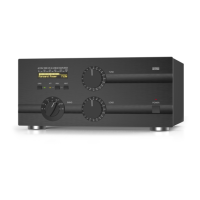c) Tuning Procedure
While a continuous carrier (CW) signal at the desired frequency is still applied:
• Look at the upper scale (forward power). Obtain maximum power using the upper TUNE
knob;
• Look at the lower (Load Cap) scale and turn the lower LOAD knob in order to center the
triangle marker at the "!" mark;
• Release the PTT shortly in order to disable the attenuator, then repeat both steps at nominal
power. Always finish by peaking with the TUNE knob.
Appearance of an arrow on either left or right TRI scale edges means that the LOAD
knob is too far from the proper position. To correct for this, turn the LOAD knob to the
prompted direction until the triangle marker appears inside the scale field.
Figure 4-1 Using TRI tuning aid
Figure 4-1 Using TRI tuning aid
Please note also, that the TRI mark will not appear until at least 5 W drive is applied, and at least 20 W
forward power is achieved.
If, for some reason, matching cannot be accomplished successfully, check BAND switch position and proper
antenna selection. Then check the antenna SWR at the same drive frequency.
d) Tuning hints
While turning the knobs, you will note that both tunings would be virtually independent. This is a benefit of
the TRI. The plate-load resistance increases to the right and decreases to the left of the TRI center.
The center of the scale corresponds to the proper LOAD capacitor tuning, which presents an optimum load
resistance to the tube.
If you tune to the right, you will obtain more gain, but less undistorted output power will be attainable.
You may prefer to use this hint when your drive power is insufficient or when you need less output but
better efficiency, for instance at heavy duty modes (RTTY, SSTV, etc.) where less heat is wanted (not only in
the amplifier but also in the transceiver).

